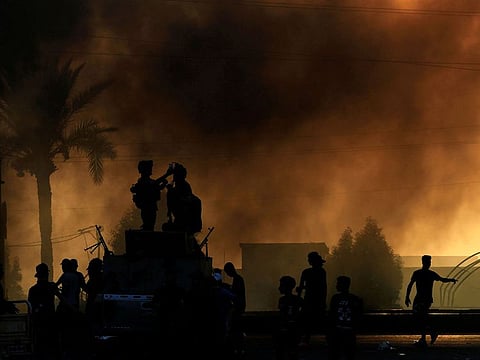UN report on Iraq leaves more questions than answers
Estimates of a million disappeared over 5 decades fails to capture full extent of problem

There is an old Arab proverb that is well known in Iraq, saying: “After much effort, he tried explaining water with water.” It is usually used to describe a confusing or illogical argument, one based on empty words rather than sound information, and can very much apply to a newly released UN report saying that an estimated one people have disappeared in Iraq over the past fifty years.
This was described as “a problem of massive proportion.” Many media outlets have actually picked up the story as “news” although there is nothing newsy about it, nor new.
Not only does it state the obvious — which we all know — but provides no accurate numbers or date analysis on when, where, and how these people disappeared, and who was responsible for their disappearance.
After much effort, it too explained water with water.
Citing “official estimates” the report says that since 1968, “between 250,000 and 1,00,000 people have disappeared, though it is impossible to provide more precise figures.” Such wide margins of estimation are commonplace in the Third World, not with a prestigious international organisation like the UN.
That statement is actually worse than the story itself. Two hundred and fifty-thousand disappearances is a ridiculously low number for a country that has lived through a sectarian civil war, a US occupation, Daesh, and Saddam Hussein. But so is the 1 million benchmark, which although probably true (if not higher), still needs proper authentication.
Independent UN experts
Released on the UN’s official website on 4 April 2023, the story was based on a November 2022 visit to Baghdad by the Committee on Enforced Disappearances, composed of ten international experts who are appointed by Geneva but are not UN staff.
Their job is to monitor global implementation of the Convention against Enforced Disappearances. They visited a provisional centre of DNA in the norther city of Sinjar, and then met with victims, and Iraqi officials who in some cases were affiliated with some of the same militias who were responsible for forced disappearances after 2003.
The UN experts complained that Iraq has failed to hold accountable those who were responsible for the more recent disappearances, calling for “investigation and legislation to eradicate this heinous crime.”
It urged Iraqi officialdom to include enforced disappearances as a separate offence in national legislation, given that it currently cannot be prosecuted, also calling for the establishment of a search and investigation strategy for all cases of disappearances, encouraging authorities to “strengthen and enlarge” the scope of forensic investigation.
All detainees need to be registered, said the report, and their relatives duly informed of their whereabouts. Iraqi officialdom needs to “clarify” persistent “allegations” of secret detention, which the state denies.
Not only do these recommendations condescending, but they are also unreachable. If Iraq were serious about this issue, it could have established proper mechanisms to track and document forced detention since signing the Convention against Enforced Disappearances back in 2010.
It didn’t need ten UN experts to tell it what had to be done, without providing the know-how, the equipment, the money, and the political incentive to go down this track, especially in a country whose wounds remain wide open and have not healed, on any front.
Five Big Waves
According to the report, the one million figure is based on five waves of disappearances since 1968, a year of upheaval that witnessed a bloodless coup bringing Ahmad Hasan Al Bakr to power. It doesn’t say if the disappearances began under Bakr (July-December 1968) or his predecessor, Abdul Rahman Aref.
Bakr was a relative and protégé of Saddam Hussein, who ruled through him from July 1968 until taking over power in July 1978. Again, there is no breakdown of how many people disappeared under Bakr first, then Saddam, leading up to the US-led invasion of 2003.
This of course, witnessed massive disappearances, both in the battles against Iran starting 1980, and in the August 1990 occupation of Kuwait in its subsequent liberation. We also had more disappearances with the Shiite uprising of 1991, and all battles waged against Iraqi Kurds.
These were monumental events in modern Iraqi history, whose disappearance toll might very much have exceeded the UN’s one million benchmark. But we cannot say for sure, given that we have no proper numbers to lean on.
It is strange why the UN report starts in 1968 and not, for example, with the 1963 coup against Abdul Karim Qassem or the 1958 revolt against King Faysal II and members of the Iraqi Royal Family. Both were very bloody and must have whipped up a massive number of disappeared persons, either killed in the mayhem, and/or abducted for being in the wrong place at the wrong time.
The UN report prefers to start with 1968, identifying the second “wave” of disappearance as during the 2003 occupation, when “at least 200,000 Iraqis” were captured by the US military.
The third wave was the one probably better documented than all the rest, pertaining to Daesh period between 2014-2017. Then came the 2018 uprising in Basra, followed by those abducted or taken away during the October 2019 Revolution. These fresher ones, technically, are also easy to document since many are still alive — yet, sadly — so are their abductors, making it more difficult to track them.
In conclusion, the new UN report on Iraq’s disappeared raises more questions than answers, failing to provide a clear path forward for addressing this issue.
— Sami Moubayed is a historian and former Carnegie scholar. He is also author of Under the Black Flag: At the frontier of the New Jihad.
Sign up for the Daily Briefing
Get the latest news and updates straight to your inbox



